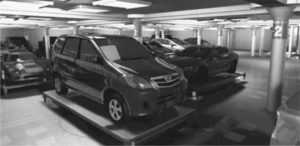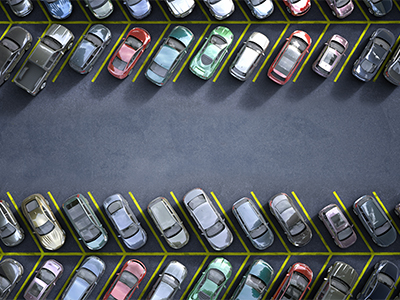Volume 39, Number 2
Fall 2014
By William ‘Ted’ Anglyn, CRE, MAI, CCIM

Photo: adike/Shutterstock.com
Parking represents an evolving $30 billion1 commercial real estate industry that is far more dynamic than perceived by most real estate professionals. Many real estate professionals see the parking industry as static, requiring little thought or attention. Still more believe there are few innovative solutions to the construction, management and operation of stacked parking garages, open lots or on-street metered spaces. Nothing could be further from the truth.
The parking industry is rapidly changing with creative revenue enhancements, technology updates, fresh designs, innovative management and new operating initiatives. Because of ever-increasing profit expectations, changing demographics and urban design differences, parking has had to quickly adapt. The face of parking is also changing because the average driver is changing. With a rapidly aging baby boomer generation living in the suburbs, and millennials flocking to the cities, sans cars, parking industry professionals have had to keep pace with the new dynamics. The result is that the value contribution of the parking component is evolving. Counselors need to be apprised of the significant changes occurring in the parking spectrum to appropriately advise clients on how to maximize their parking facilities for greater real estate investment returns. Often, parking revenue is considered a secondary income source with minimal value impacts, however, with evolving technology the returns for a property’s parking component can add significantly to real estate returns while improving the customer experience. Parking facility monetization is also gaining momentum. “More than $2 billion was spent by infrastructure funds to acquire the parking concessions at The Ohio State University campus ($483 million), Chicago on-street meters ($1.15 billion) and Chicago Millennium Garages ($563 million)”.2 These three recent transactions represent “more than the value of the top North American parking companies.”3
If these three transactions are any indicator, more and more investment capital is going to focus on parking facilities as well as on the parking industry. Industry professionals should understand the trends behind the changing face of parking. Two key trend areas are technology impacts and societal demand factors.
Technology Impacts
Technology continues to push the parking industry in new directions. As such, exciting new developments such as real-time dynamic pricing models, greater use of advance reservations, mobile parking applications and mechanical parking systems are becoming more commonplace. The following technology trends are changing the parking landscape:
- Connected Car: The connected car (car with Internet access) has gone from being a novelty to a major requirement of new car shoppers. Connected cars can load real-time data regarding parking availability, traffic conditions and estimated arrival time. Parking inefficiencies result in high costs to the consumer. With connected cars, these costs are reduced in large part because of the parking apps and the efficiencies gained by their use.
- Dynamic Pricing: Dynamic pricing models allow for variable pricing of parking spaces based on many different supply and demand factors including: time of day, current vacancy, turnover rate and special events. This new approach is becoming more popular as parking operators are seeking to maximize revenue streams. Dynamic pricing will optimize parking revenues when demand is higher (analogous to the last seats on a plane) and allow real-time pricing flexibility during low demand periods. The revenue implications of dynamic pricing are significant.
- Mobile Apps: Mobile phones already are being used for payment, searches, reservations and identification in parking facilities. Th is technology reduces drive times and informs customers of parking availability for spaces that are marketed through these mediums. A popular service with a corresponding app is Parkopedia, or “Wikipedia for parking.” This app helps people find spaces and helps owners fill these spaces. Bottom line: online parking applications help reduce wasted space, help customers have a better parking experience and will, no doubt, serve as a source of new parking data to help owners and operators maximize parking facility revenue.
- Online Reservations: With high gas prices, customers are less willing to circle the block wandering aimlessly for a space. Parking facility operators understand this frustration and are developing new systems to enable online reservations for specific parking spaces in their facilities. This enhancement will ensure customers have parking destinations even before they depart. Online reservations are available directly through operator websites and also through many mobile apps.
- Payment Types: Parking has in many instances been a cash business, but with the onset of digital payments, currency and reservations, the process of paying without cash has become significantly easier. Consumers have come to expect card payments to be accepted everywhere, and more and more parking facilities accept them. Europe and Canada have actually been quicker to adopt the use of credit cards than has the United States, and process a much higher percentage of their transactions via credit card. In general, having fewer cash payments is perceived to benefit parking facility net revenue because of reduced slippage.
- LPR: License Plate Recognition is a technology used to assist in parking enforcement. Integrated with mobile apps and connected cars, this technology can remove the need for human enforcement and can make parking more convenient for the clients. Expenses and income will be easier to track as there will be fewer opportunities for parkers to violate the pay per space model. Improvements to make these technologies more reliable will likely be added to existing parking facilities and be considered in the construction of new parking facilities. Enforcing against violators and maintaining monthly payment information via LPR is another way to be more efficient and remove human error.
Figure 1: High Density Vehicle Storage

Source: Park Plus, Inc.
- Mechanical Parking Systems: Mechanical parking systems are gaining momentum in high value (high density) real estate markets. These revolutionary parking systems are dramatically reducing the typical square footage required per parking space. The increased efficiency is further enhanced by reducing the number of drive aisles and ramps that traditional garages require. Lower ceiling heights also are possible, which allows for even greater parking density (overall total space savings can range from 50 to 66 percent). This technology has the potential to enable developers to consider sites that in the past were deemed not profitable because of the cost to develop subterranean parking or the overall inability to provide adequate parking. Many of these new mechanical parking systems are automated and do not require staffing to operate, which also reduces operating costs.
Technology Impact Summary
Technology significantly benefits revenue with both increased pricing flexibility and greater occupancy, but likely the most immediate benefit is reduced operating costs. An obvious side effect of the other upgrades in parking technology and vehicle features is the reduced need for human input in the field. Features such as payment collections to ticket monitoring to revenue calculation and more can be done remotely. College campuses, hospitals, office complexes and stadiums are turning to parking management companies that, in turn, are relying less on human staff.
Societal Demand Factors
In a 2013 International Parking Institute survey,4 parking market participants identified societal changes most significant to the parking industry. The most significant responses in order are as follows:
- Traffic Congestion: More and more people are moving to urban areas. While young drivers are decreasing overall, this trend may change as millennials enter the workforce in higher numbers. City planners are also making attempts to have smarter paid parking versus superfluous “free parking.”
- Gasoline Prices: Though usually fluctuating, gas prices have remained at historic highs. A significant amount of drive time is wasted in attempting to find a parking space, so as gas prices continue to rise commuters are less willing use additional gas to find a space. Customers are turning to digital solutions to find a parking spot or make a parking reservation. High gas prices also are encouraging consumers to consider electric or natural gas vehicles. Electric charging stations are beginning to appear in parking facilities and present some unique challenges for parking lot owners and operators.
- Desire for Livable/Walkable Communities: Generational factors come into play here. Young commuters prefer to be close to work and within walking distances to their favorite events, eateries and services. Older commuters tend to live further away and drive longer distances. New community designs that integrate work and play within the same areas change the needs for parking as well as for general vehicular access.
- Focus on Environment and Sustainability: The green movement has increased interest in environmentally friendly cars and more sustainable land uses. The result for the parking industry has been more multi-purpose parking facilities and less redundant parking design. Trendy garages have been used to host weddings, parties and other events. Stylish parking facilities add to, rather than detract from, the urban landscape. Some garages even feature recreational uses on the roof.
- Aging Population: Baby boomers represent a huge portion of the population and they are slow to leave the workforce. As this generation continues to commute and purchase vehicles, they will continue to demand parking.
- Increase in Mass Transit Use: While mass transit has its challenges (and in many areas of the country is not available), there are still larger numbers of people turning to mass transit in order to save on gas, help the environment and avoid the stress of parking.
- Use of Bicycles for Commuting: Commuters are pursuing travel alternatives that are good for the environment and personal health. Bicycle commuting is made even more common by the influx of young professionals moving closer to their workplaces and urban areas in general. Parking facilities have to adapt in certain markets to increased bicycle demand.
- Migration to Urban Areas: As previously noted, professionals are choosing to live closer to work, which means even more population density in urban areas.
- Concerns about Safety: Parking garages and lots have developed a negative reputation over the years and many drivers are wary of where they park. To combat this issue, operators are seeking to improve facility lighting, security and navigability as well as to place parking in locations convenient for walking at different times of the day.
- Desire for Aesthetic Design: Parking garages have also developed a negative reputation for their appearance. Architects and city planners are using more creative ways to present parking facilities and have made huge progress both in the feasibility of design and in the multi-use nature of the buildings. This trend has redefined what many people would even consider to be a parking garage.
Other Changes (not noted in the survey) with Potential to Affect Counselors
- Densification of Office Space: The space per square foot per employee in newly leased office space went from 300–350 square feet per person in 2005 to 150–200 square feet in 2010. Some of this reduction is linked to the recent recession, but much of it is because of open office design and the predominance of electronic storage which reduces the need for physical file storage. This change has the potential to increase the typical office demand parking ratios from three to four spaces per 1,000 square feet to five to six spaces per 1,000 square feet.
- Growing Vehicle Population: The vehicle population in the U.S. continues to increase, with the average vehicles per household rising more than 12 percent from 2000 to 2009.5 As the number of vehicles increases, so does the demand for parking.
Conclusion
Parking represents a dynamic industry. Via technology enhancements, owners/operators are making greater efforts to fill their garages at higher rates with reduced costs. Social media, Internet marketing, increased reservation system use and dynamic pricing are enhancing property revenue while technology enhancements are reducing payroll and other key operating costs. The net result is that more and more property owners are realizing greater value from their existing parking structures; for new parking structures in densely developed, high land value markets, developers are maximizing potential with the advent of mechanical parking systems. Societal changes are affecting parking investment decisions as people are more cost conscious and more cognizant of environmental issues; these changes are ironically tempered by densification of office space as well as overall vehicle ownership. Counselors need to be apprised of these significant changes to appropriately advise clients on how to maximize their parking facilities for greater real estate investment returns. ■
The author wishes to thank Mary Smith of Walker Parking Consultants and Ryan Astrup with Park Plus, Inc., for their input on this article.
Endnotes
1. International Parking Institute, “2013 Emerging Trends in Parking,” May 2013. ↩
2. Munn, Charles R. III, “Public/Private Partnerships and the Parking Industry, Part 1: What’s Driving the Deals,” Parking Magazine, October 2013. ↩
3. Ibid. ↩
4. International Parking Institute, op. cit. ↩
5. National Parking Association, “The NPA Parking Demand Report, 2013–2015 Market Forecast,” a Denison Parking and NPA Research Partnership, 2013. ↩






